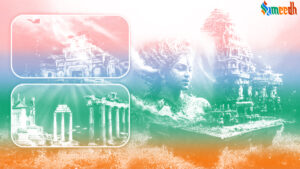The submergence of the city of Dwarka into the sea is a significant event in Hindu mythology and is often associated with the Yadava clan, which included Lord Krushna and his family. The story is narrated in various Purans, including the Bhagavat Purana and the Harivamsa.

After the Battle of Kurukshetra, in which the Yadavas played a significant role, Gandhari, the mother of the Kauravs, was grief-stricken due to the loss of her sons. In her sorrow and anger, she cursed Lord Krushna and the Yadava clan, predicting their destruction.
Following the curse, a conflict arose among the Yadavas. The Yadava men, under the influence of an intoxicating substance, engaged in a drunken brawl at an event in Prabhas. In the course of the altercation, a fight broke out among them. During the quarrel, a powerful hunter named Jara, mistaking Lord Krushna for a deer, shot an arrow that fatally wounded Krushna. Krushna, aware of the divine plan, accepted his destiny and left his mortal body.
After Krushna’s departure, a series of cataclysmic events unfolded. The city of Dwarka faced heavy floods and tidal waves. Ultimately, Dwarka was submerged into the sea. The destruction of Dwarka is often described as a part of the divine plan and the culmination of the curse, resulting in the end of the Yadava dynasty.
While the city of Dwarka was physically destroyed, Lord Krushna, being the Supreme Being, returned to the spiritual realm. The submergence of Dwarka is often viewed as a symbol of the impermanence of the material world and the eternal nature of the divine.
The submergence of Dwarka is a significant event in Hindu mythology and is often interpreted metaphorically, symbolizing the cyclical nature of creation, preservation, and destruction. Devotees believe that Lord Krushna’s departure marked the completion of his earthly pastimes, and his divine presence continues to be revered in the hearts of his devotees. The story is found in various Purans and is particularly detailed in the 11th and 12th books of the Bhagavad Puran.